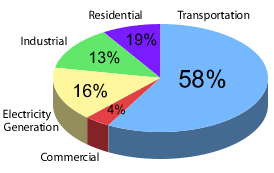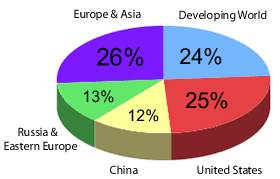Energy Efficiency Helps Combat Climate Change
What's New With Climate Change in California?
June 21 , 2007: California Air Resources Board (CARB) adopted a list of early action measures to get the state moving toward the AB 32 goal. Read the Proposed Early Action Measures to Mitigate Climate Change in California.
September 27, 2006: Gov. Arnold Schwarzenegger signs Assembly Bill 32, "The Global Warming Solutions Act of 2006", requiring the California Air Resources Board (CARB) to develop regulations and market mechanisms that will ultimately reduce California's greenhouse gas emissions by 25 percent by 2020. Read AB 32 in its entirety or view the AB 32 one-page fact sheet.
June 1, 2005: Gov. Arnold Schwarzenegger signed an executive order creating California's first official timetable for reducing overall greenhouse gas (GHG) emissions. Executive Order S-3-05 sets the following non-binding targets: reduce GHG levels to 2000 levels by 2010 (an 11% reduction over business-as-usual), to 1990 levels by 2020 (about 25% lower than business-as-usual) and to 80% below 1990 levels by 2050. The secretary of the California Environmental Protection Agency is required to report to the Governor and the State Legislature biannually on California's progress toward these goals, and on the effects of climate change in California. View executive Order S-3-05.
California Fossil Fuel CO2 Emission Sources, 1999

(Inventory of California Greenhouse Gas Emissions and Sinks: 1990-1999, California Energy Commission)
March 24, 2005: California Energy Commission released a draft staff report that provides background and context to guide the formulation of policy options for reducing GHG emissions in California. Read the report. (616 kb, PDF)
February 23, 2005: California Public Utilities Commission held a public meeting to begin to identify best practices for all CPUC-regulated companies to reduce greenhouse gas emissions.
View the ruling, agenda, presentations and handouts on ways to incorporate climate change issues into energy efficiency policies and programs.
Is Global Climate Change Real?
Global climate change is real. The vast majority of the world's leading scientific experts agree that greenhouse gases (GHG) affect climate by increasing the "greenhouse effect." The gases concentrate in the Earth's atmosphere and trap heat by blocking some of the long-wave energy the Earth normally radiates back to space. Activities such as the burning of fossil fuels (coal, oil and natural gas for heating and electricity, gasoline and diesel for transportation); deforestation activities; and some agricultural practices are increasing the greenhouse gases in the Earth's atmosphere and accelerating global climate change. 1
U.S. CO2 Emissions vs. World

(Chart found in AB1493 Presentation, p. 15, title: "United States is the single largest contributor to greenhouse gas emissions", source: U.S. EPA Global Warming Website In 1998 CO2 Equivalents)
In the United States, greenhouse gas levels are rising. The United States presently emits one-quarter of the world's greenhouse gases – more than any other country, both per capita and in total. In the United States:
- Approximately 6.6 tons (almost 15,000 pounds carbon equivalent) of greenhouse gases are emitted per person every year.
- Emissions per person increased about 3.4% between 1990 and 1997.
Most of these emissions (about 82%) are from burning fossil fuels, such as oil, coal and gas, to generate electricity and power our cars. The remaining emissions are from methane from wastes in our landfills, raising livestock, natural gas pipelines, and coal, as well as from industrial chemicals and other sources.
In California, transportation is the source of more than half of the carbon dioxide emissions from fossil fuels. 2 California Energy Commission forecasts fuel use in California's transportation sector to increase from 1990 levels by 60% through 2020. Despite current policies promoting renewable energy and energy efficiency that are reducing greenhouse gas emissions significantly, total GHG emissions in California are still projected to grow 32% from 1990 levels by 2020 unless additional policy changes are made.
What Impacts Will It Have in California?
Climate change will have severe impacts in California. Climate change challenges the state's water supply, agriculture, forestry, energy production, health, transportation, tourism and much more.
According to the National Academy of Sciences, under a low-emissions scenario by the year 2100:
- Heat waves and extreme heat in Los Angeles quadruple in frequency while heat-related mortality increases two to three times,
- Alpine sub alpine forests are reduced by 50 to 75%,
- And Sierra snow pack is reduced 30 to 70%.
Under a higher emissions scenario by 2100:
- Heat waves in Los Angeles are six to eight times more frequent, with heat-related excess mortality increasing five to seven times,
- Alpine and sub alpine forests are reduced by 75 to 90%,
- Snow pack declines 73 to 90%, with cascading impacts on runoff and stream flow that, combined with projected modest declines in winter precipitation, could fundamentally disrupt California's water rights system.
What Can You Do to Combat Climate Change?
Reduce your energy and water use. More than 80% of the electricity we use in California comes from non-renewable resources like coal and natural gas. The more efficiently and wisely we use energy in our homes, at work and on the road, the more global warming emissions we can prevent. And because transporting and treating water requires about 10% of the state's energy annually, using water more efficiently also means using less energy.
Throughout California, the United States and the world, governments and businesses are working actively to reduce greenhouse gas emissions.
Additional Resources
- Global Climate Change: In Support of the 2005 Integrated Energy Policy Report, California Energy Commission (June, 2005) (581 kb, PDF)
- Energy Efficiency and Climate Change, by Arthur Rosenfeld, Pat McAuliffe and John Wilson (2004) (118 kb, PDF)
- Emissions pathways, climate change, and impacts on California, National Academy of Sciences (August, 2004) (485 kb, PDF)
- Climate Change and California, California Energy Commission Final Staff Report. Support document to the Integrated Energy Policy Report. (Publication # 100-03-017F). (November, 2003) (769 kb, PDF)
- Global Climate Change and California: Potential Implications for Ecosystems, Health, and the Economy. PIER Program Consultant Report (Publication # 500-03-099C on California Energy Commission Website). (November, 2003) (link)
- Degrees of Danger -How Smarter Energy Choices can Protect our Health in California. Physicians for Social Responsibility (April, 2003). (615 kb, PDF)
- Climate Change in California: Choosing Our Future. Union of Concerned Scientists, (September, 2004). www.climatechoices.org










